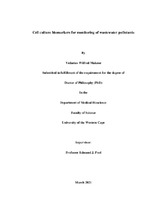| dc.contributor.advisor | Pool, Edmund J. | |
| dc.contributor.author | Makene, Vedastus Wilfred | |
| dc.date.accessioned | 2021-04-07T07:26:17Z | |
| dc.date.available | 2021-04-07T07:26:17Z | |
| dc.date.issued | 2021 | |
| dc.identifier.uri | http://hdl.handle.net/11394/8148 | |
| dc.description | Philosophiae Doctor - PhD | en_US |
| dc.description.abstract | Wastewater is normally composed of a mixture of pollutants. The type and composition of pollutants in a particular wastewater depend on the source of origin. The source and characteristics of a particular wastewater determine the ideal method of sewage treatment. Specific treatment techniques are effective in the removal of certain types of pollutants and may have no impact on the levels of other types of pollutants. Therefore, a combination of treatments and assessment of the quality of effluent before release into the environment is normally recommended. The assessment of effluent can be achieved by various techniques including chemical analysis and biological assays. Chemical analyses are commonly employed; however, they often pose detection problems and are considered to be uneconomical. | en_US |
| dc.language.iso | en | en_US |
| dc.publisher | University of the Western Cape | en_US |
| dc.subject | Biomarkers | en_US |
| dc.subject | Wastewater pollutants | en_US |
| dc.subject | Water pollution | en_US |
| dc.subject | Biological assays | en_US |
| dc.subject | Mouse macrophage RAW264.7 | en_US |
| dc.title | Cell culture biomarkers for monitoring of wastewater pollutants | en_US |
| dc.rights.holder | University of the Western Cape | en_US |

